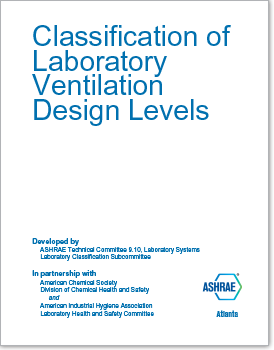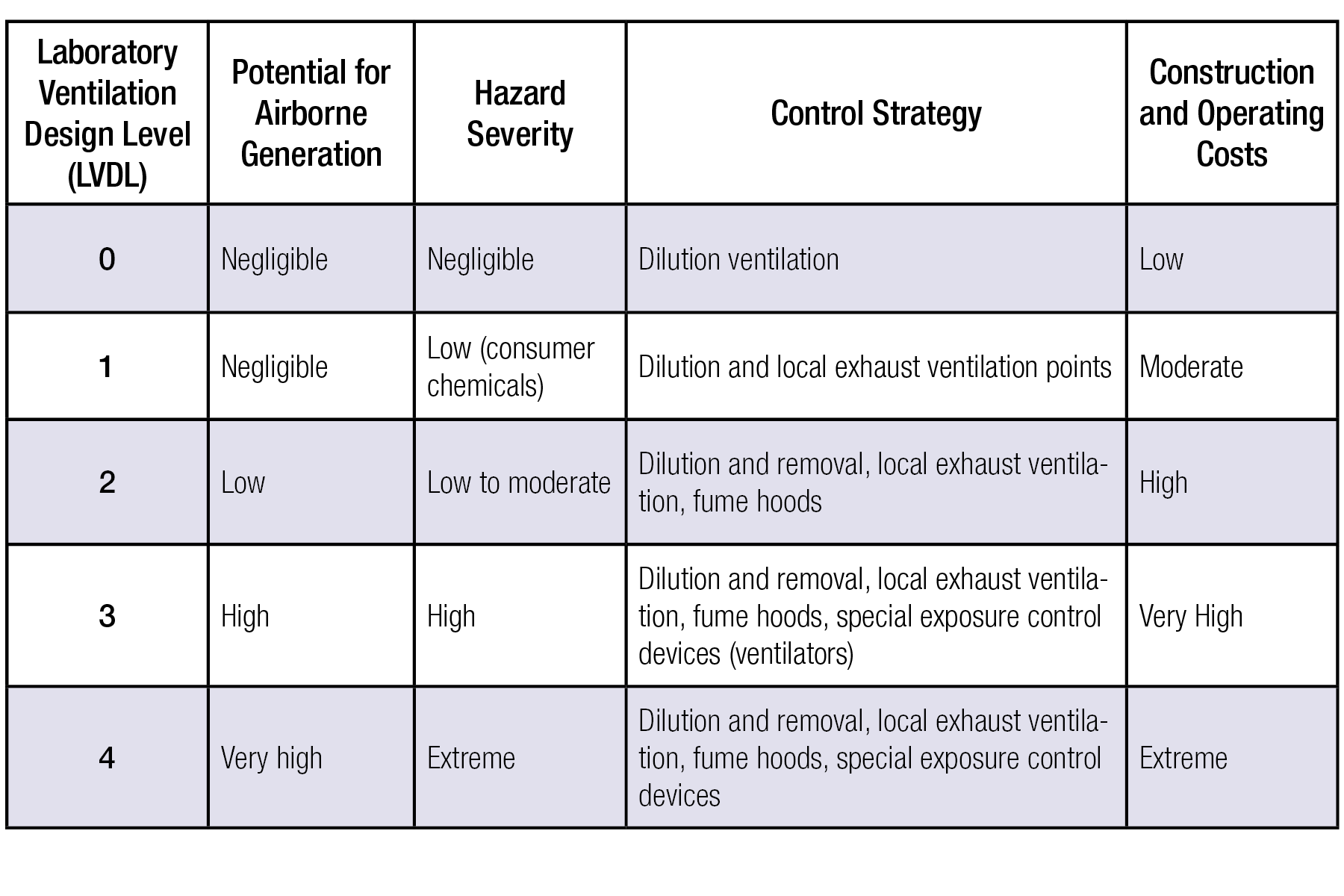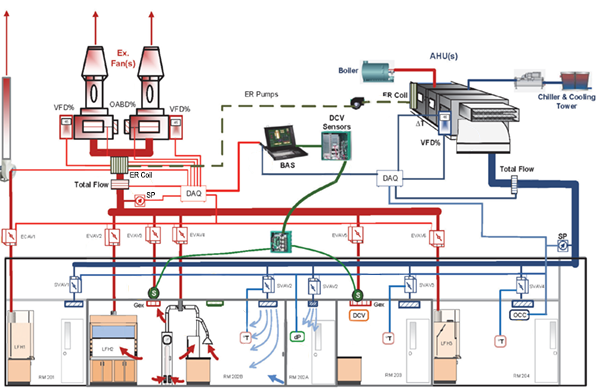
The COVID-19 pandemic exposed the need for more information in fighting contagious diseases. Research on its causes, controls and cures spiked and continue still as the world attempts to protect against such viruses. Of course, laboratories work on a variety of projects in addition to contagious diseases and all need varying levels of protection to maintain a safe work environment. The need for safe laboratory ventilation always exists, regardless of the type of research conducted. However, questions remain when it comes to specifying these ventilation systems, specifically laboratory exhaust systems. What is the proper level of protection to specify?
The answer is, it depends. A one-size-fits-all approach to laboratory ventilation is not the answer as the level and type of research done in laboratories varies. A high school lab does not have the same requirements as a laboratory doing research on infectious diseases. Fortunately, there is help.
The American Society of Heating, Refrigerating and Air-Conditioning Engineers (ASHRAE) have released a publication that will help. Classification of Laboratory Design Levels is a guide that addresses:
• Design and operation of laboratories
• Interactions with laboratory airflow control systems (LACSs) that provide conditioning
• Control of environmental air quality in a laboratory
 |
The classification guide breaks laboratories down into five levels of increasing hazard (Table 1) and describes the type of equipment and controls needed for each design level.
The laboratory ventilation design levels (LVDL) are:
 |
| Table 1 |
An illustration in the shows a typical lab (Figure 1) with primary air control components and features. The illustration provides a description of these items, why each is important, and how these may be utilized at each design level.
 |
| Figure 1 – represents a simplified diagram of a laboratory and LACS showing critical components. (Image courtesy of The American Society of Heating, Refrigerating and Air-Conditioning Engineers. (ASHRAE)) |
ASHRAE’s guide covers the entire spectrum of ventilation for laboratories. For simplification, let’s focus on items to consider when designing laboratory exhaust system and the LVDL. These include fan redundancy, protection of fan drive components from the airstream, a bypass air plenum and damper, drive type, fan discharge, and system height.
Number of Exhaust Fans – Fan Redundancy
Quantity of fans in an exhaust system depends on the amount of air being exhausted, LVDL recommendation on equipment redundancy and the results of a risk assessment performed during the design process.
Single fan use in LVDL 0, 1 or 2 laboratories is acceptable and if the laboratory risk assessment is a low. The use of a single fan is often with dedicated exhaust to a single hood or space.
ASHRAE LVDL 3 or 4 recommends equipment redundancy. Redundancy provides a back-up fan in the event of a failure to maintain containment in the laboratory. This recommendation is an important consideration as the hazard level increases along with the hazard potential of the work being performed in the facility.
Multiple fans offer system redundancy and higher system airflow capacities when multiple hoods are manifolded together. In addition, multiple fans provide the control option to stage fan operation, reducing operational costs when risk levels are monitored. Ventilation rates for occupied or unoccupied laboratories per ASHREA 62.1 increase with LVDL or by the effectiveness. While safety is the primary concern, different air change rates (ACH) rates present an opportunity to save on operational costs through reduced treatment to supply air and also exhaust fan energy saving through staging fan operation.
Reference the Greenheck Fresh Air blog post on laboratory exhaust redundancy for descriptions of the different types.
Airstream Protection
Personnel protection is at the center of the LDVL discussion. The airborne discharge of chemicals or hazardous materials from the laboratory poses a risk for individuals on the rooftop. An aspect sometimes overlooked is the handling of exposed airstream components when performing maintenance or repairs. A fan system with a sealed airstream provides a protective cover and gasketing for drive components, such as the motor, shaft, bearings, and sheaves to protect against contaminants, but still within the airstream. This design is acceptable when the degree of hazard severity is between negligible to moderate depending on the chemical. Service may require coming in contact with parts sealing the drive components. The alternative to a sealed airstream is an isolated one. Drive components are completely outside of the contaminated airstream. Two housing designs that feature an isolated airstream are the scrolled centrifugal and bifurcated housing designs, allowing for safer inspection or service by maintenance personnel.
Appropriate personal protective equipment should be worn when servicing a laboratory exhaust system.
Exhaust Fan Discharge
Exhaust discharge becomes more critical as the design level increases. Three different discharge types are available that address design level requirements, add to the height of the system and produce a high-velocity discharge that helps in the dispersion of the contaminated plume.
A high plume nozzle is an engineered cone producing higher discharge velocities and increasing the exhaust effluent plume height Effective plume height, which includes the fan system height and exhaust effluent plume height, is important in preventing contaminated exhaust effluent from being re-entrained into the laboratory or adjacent buildings through make-up air systems or windows.
A high plume dilution wind band combined with a high-velocity nozzle entrains outside air, diluting the exhaust effluent and directs exhaust airstream up away from the building. Dilution provides for lower contaminant concentration levels downwind of the exhaust system.
A variable geometry nozzle maintains a high-discharge velocity in a variable volume laboratory application without passing air through the bypass air damper. Energy costs are reduced by slowing the fan speed and not bypassing outside air while still having a high discharge plume height.
Bypass Air Plenum and Damper
Dilution is a control strategy for all five LVDL categories. It limits exposure risk inside the laboratory and also reduces the contamination risk from the discharge exhaust effluent. Dilution comes with the price of high ventilation rates, and combined with laboratories often requiring 100% outside air, it is a large operating expense. This expense is where an exhaust system with a plenum and bypass air damper can help.
As a system control strategy to reduce the operating costs associated with dilution rates and high-level LVDL categories, many laboratories utilize a variable volume exhaust system. Variable air volume (VAV) laboratory systems save operation costs by reducing the amount of conditioned air exhausted during periods when high ventilation rates are not required. The building’s laboratory exhaust requirements such as effective plume height and dilution levels are maintained during these periods utilizing unconditioned air, from outside the building, to make up the difference with a bypass damper and plenum. An exhaust system’s bypass damper(s) percent open position is modulated to balance laboratory airflow rates and also satisfy a constant airflow through the exhaust fan. The VAV control strategy, including a plenum and bypass air damper, reduces operating expenses and maintains laboratory safety both inside and out.
System Height
System height, including stack height, is mentioned as a component of modern laboratory control systems in the ASHRAE guide. It is a safety consideration in laboratory exhaust systems for all LVDL classifications to protect maintenance personnel. Both NFPA 45 and the ANSI/AIHA Z9.5 - Laboratory Design Guide, recommend a minimum of a ten-foot-high system discharge height protecting individuals on the roof deck from inhaling or contacting contaminated exhaust effluent or particulates.
Drive Type
Fans used in laboratory exhaust utilize one of two drive system types; belt or direct drive. All the LVDL categories discuss redundancy and control strategies to lower operating costs in laboratories. Lower operating costs also relates to the choice of drive type utilized in the exhaust system.
Belt drive systems have a motor, fan drive shaft, high-performance bearings, and a set of belts and sheaves. Recommendations call for belt drive exhaust system to utilize a minimum of two belts with a 2.0 drive service factor. This two-belt minimum provides for system redundancy and reliability. Should a belt break, the remaining belts can handle 100% of the load without losing containment in the fume hood.
Direct drive systems have fewer components for potential failure and require less maintenance. Fans with a direct drive system are more efficient, eliminating losses through the fan belts, pulleys and fan shaft bearings. If paired with a variable frequency drive (VFD) provides for potential operational cost savings when adjusting the fan speed to match varying flows from the laboratory.
Additional Considerations
Other features also play a role in determining the best laboratory exhaust system with corresponding laboratory LDVL and overall laboratory risk assessment. These include footprint, overall height, sound, and weight.
Learn more about laboratory exhaust systems here or redundant lab exhaust systems. You can also learn more about LDVL by downloading the Classification of Laboratory Design Levels. It is free to download on the ASHRAE website or from TechStreet.
Laboratory Exhaust

from